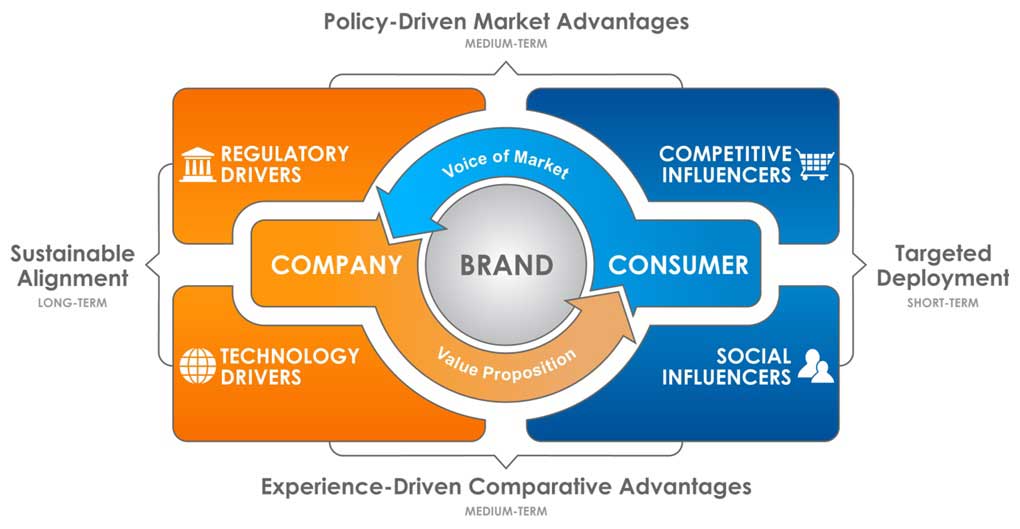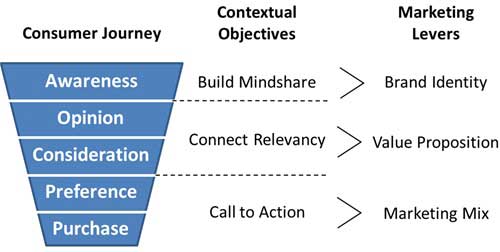In Part 1, we saw that it is necessary to move beyond short-term value propositions to build brand loyalty; specifically, a contextual marketing strategy that uses industry and market drivers and influencers to build brand loyalty is the way to achieve competitive advantage.
We discussed how to create a long-term sustainable alignment for your business and how to create medium-term policy-driven market advantages.
In Part 2, we will describe two more strategies that harness those drivers and influencers.

How to Create Experience-Driven Comparative Advantages
One of the most difficult jobs for marketers is creating truly differentiated customer experiences. Industrial design can be duplicated, but replicating an experience is much tougher. Technology companies have chased the iPod, iPhone, and iPad but can't replicate the intangible unique experience that is Apple. Today, products cannot rely solely on industrial design attributes for competitive advantage.
Companies make the mistake of building an experience around industrial design—rather than building industrial design around the experience. The latter concept is no different from how we live our daily lives. When planning a vacation, we first choose a destination (the experience) and then construct our itinerary around it. Companies must think about the "destination" as the experience for customers, and build brand cues (styling, features) to create that experience.
Choosing the right experiences is crucial because selectivity shapes brand identity without risk of diluting the experience. Steve Jobs believed that the hardest decisions to make in designing products is not determining what a product will do but rather determining what it will not do.
In contextual marketing strategy, delivering the right experiences to consumers means matching the right technology drivers with the right social influencers to gain a medium-term advantage. That is where the value proposition is formed. For example:
- Foursquare merges social networking trends with location-based service (LBS) technology to create a real-time, socially connected experience.
- P&G's Tide Pod product reinvigorated a category that already had 100% household penetration into a timesaving and convenient laundry experience.
- Redbox transformed the DVD rental experience by recognizing a market for value-driven, impulse rentals, and by putting kiosks in key distribution points.
- Fresh Direct merged the convenience of same-day home delivery with online grocery shopping.
- The Nike+ product line infuses technology that measures athletic performance and brings the spirit of competition to customers' social networks.
Those examples point out specific solutions that are tailored for specific experiences. In the case of Tide Pods, Redbox, and Fresh Direct, the value proposition is about speed and convenience. Nike+ and Foursquare focus on staying connected. All of these companies discovered how to harness their products' experiential attributes to strengthen brand engagement and loyalty.
How to Create Targeted Deployment
Targeted deployment focuses on the tactical execution, generally lasting one-year, of communicating a brand's value proposition and unlocking competitive advantages from the contextual strategies that are already in place. The key is to make use of the two forces that drive purchasing behavior—competitive influencers and social influencers—to optimize go-to-market planning.
That method is consistent with traditional brand planning, which typically entails market analysis, product positioning strategy, marketing mix, customer acquisition/retention strategy, and business targets. Optimizing each of those components requires a thorough understanding of social influencer and competitive influencer forces.
In Part 1, I referenced the recession's impact on brand loyalty. Value propositions became the norm and most companies used traditional tactics: deep discounting, value-packaging, and reducing overhead.
However, a handful of companies broke through the norm and were able to thrive early in the recession by designing marketing programs that were contextually relevant to their customers. They recognized how "value" changed in their customers' mindset—whether a $1 discount, a free meal, or simply the value of peace of mind. Consider these examples:
- Hyundai Assurance (Job-Protection) Plan. At the height of the recession, Hyundai launched a unique program to address job uncertainty. The Hyundai Assurance program enabled customers to return any new Hyundai leased or financed in 2009 if they lost their job within one year. The company recognized that consumers sought value that extended beyond price, specifically the need for peace of mind during uncertain times. Although auto industry sales declined a staggering 21% in 2009, Hyundai increased its sales 8% and its market share 40%.
- Subway's $5 Footlong. By reducing the price of the "footlong" by only $1, Subway was able to create a national phenomenon that led to a 17% lift in US sales at a time when nearly all other restaurant sales declined. It nailed a marketing program that was contextually relevant for consumers who were both value-conscious and health-conscious. The program offered two products in one: one 12-inch or two 6-inch subs.
- Denny's "Free Grand Slam" Day. Families were dining out less frequently, which offered Denny's an opportunity to highlight its position as a value offering. Its timeliness also built positive associations with the Denny's brand, especially during a time when "corporate greed" was top news in the media. The effort brought in an estimated $50 million in earned media and publicity.
Those companies did not simply engage in a direct price war with competitors. They reframed their existing value propositions in the eyes of their customers in ways that were contextually relevant. Think about how your customers see "value," not solely relative to your competitors but also relative to their environment.
It's critical to understand that a product's "value" to a consumer is not only the price tag but also the feeling engendered in the consumer by the purchase of the product. Accordingly, success depends on your marketing program's ability to meet three key objectives:
- Building mindshare. This objective is important for new brands. Execution must have a "stickiness" factor that helps customers sort through the cluttered product category by building top-of-mind awareness for your brand. This is where brand identity is formed, so brand values and brand cues are emphasized.
- Connecting relevancy. Reinforce the contextual relevance of your brand with its target customer. Messaging connects the brand attributes to consumer needs. This is where experience-driven comparative advantages are made use of and the value proposition is communicated.
- Calling to action. Focus on consumers who are comparing products and are ready to buy. Optimize the marketing mix to ensure your brand is brought to market in the most efficient way to drive demand.

All go-to-market plans must meet these objectives, but also prioritize and emphasize the appropriate marketing levers.
And, finally, by using the four strategies outlined in this article series, you have tools more effective than short-term value propositions, and you have the power to create lasting brand loyalty.
Articles in this two-part series:







